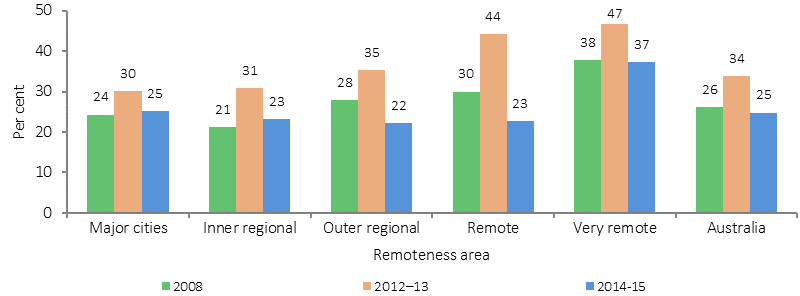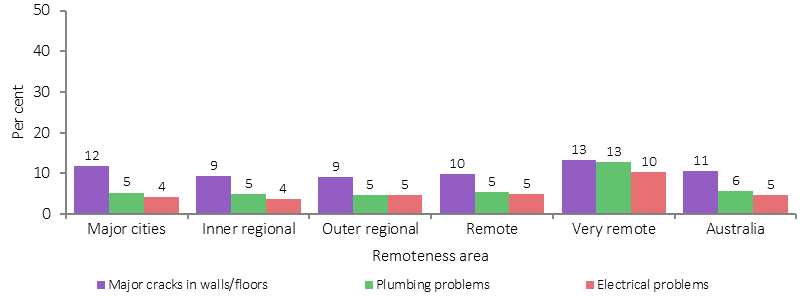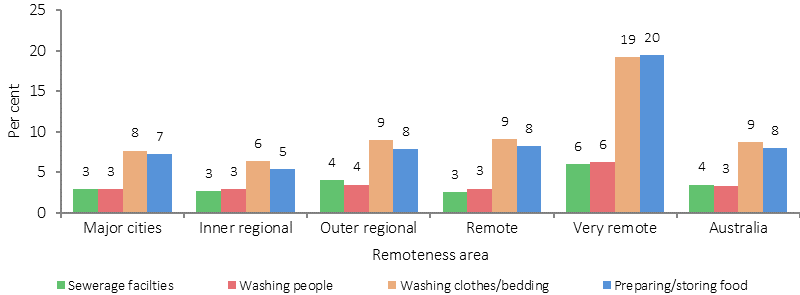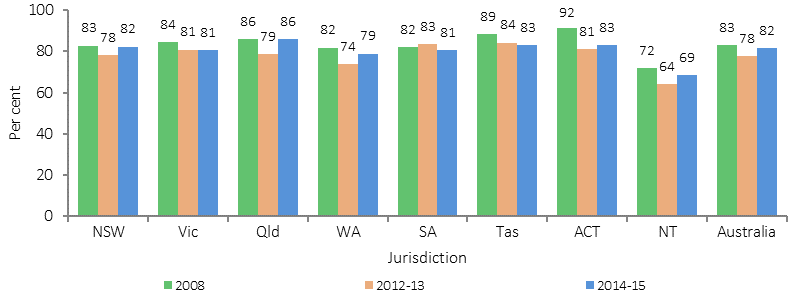2.02 Access to functional housing with utilities
Page content
Why is it important?
Housing is an important mediating factor for health and wellbeing. Functional housing encompasses basic services/facilities, infrastructure and habitability. These factors combined enable households to carry out healthy living practices including waste removal; maintaining cleanliness through washing people, clothing and bedding; managing environmental risk factors such as electrical safety and temperature in the living environment; controlling air pollution for allergens; and preparing food safely (Bailie, RS & Wayte, 2006; Nganampa Health Council et al, 1987; Department of Family and Community Services, 2003).
Children who live in a dwelling that is badly deteriorated have been found to have poorer physical health outcomes and social and emotional wellbeing compared with those growing up in a dwelling in excellent condition (Dockery et al, 2013). Social and emotional wellbeing is more strongly associated with external building condition than physical health, however this is likely to be due to other factors that are linked to building condition.
Comparisons between Indigenous and non-Indigenous children in the Longitudinal Study of Australian Children (LSAC) show improvements in housing can be expected to translate into gains for Indigenous children's health, social, and learning outcomes (Dockery et al, 2013). As expected, housing variables are closely associated with socio-economic status, including: overcrowding, renting rather than owning, and being in financial stress (see measures 2.01 and 2.08).
Infectious diseases are more common in households with poor housing conditions. For example, trachoma and acute rheumatic fever are present almost exclusively in remote areas (see measures 1.06 and 1.16). Domestic infrastructure, along with overcrowding and exposure to tobacco smoke increases the risk of otitis media in children (Jervis-Bardy et al, 2014) (see measures 1.15, 2.01 and 2.03).
Findings
The 2014–15 Social Survey collected data on household facilities and structural problems. In 2014–15, 18% of Indigenous households were living in houses of an unacceptable standard (more than two major structural problems and less than 4 working facilities for washing people, clothes/bedding, storing/preparing food, and sewerage). There has been an increase in the proportion of Indigenous households living in houses of an acceptable standard, from 78% in 2012–13, to 82% in 2014–15. The highest proportion of people living in houses of an acceptable standard was in Qld (86%) and the lowest was in the NT (69%).
In 2014–15, around one-quarter (26%) of Indigenous households were living in dwellings with major structural problems (including problems such as sinking/moving foundations, sagging floors, wood rot/termite damage and roof defects). This was similar to 2008 (26%) and a fall from 2012–13 (34%). In very remote areas, 37% of Indigenous households were living in dwellings with major structural problems compared with 25% of households in major cities. Around one in ten (11%) of Indigenous households reported major cracks in walls/floors. In very remote areas plumbing problems (13%) and electrical problems (10%) represented major issues in terms of health and safety within homes. In 2014–15, Aboriginal and Torres Strait Islander households experienced at least one type of major structural problem at nearly twice the rate for non-Indigenous households (26% compared with 14% respectively).
Facilities that support healthy living practices include sewerage, washing (people and clothes/bedding) and food preparation/storage. In 2014–15, in remote areas one in every six (15%) households did not have working facilities for preparing food, compared with 7% in non-remote areas. Likewise, 15% of households in remote areas did not have facilities for washing clothes and bedding compared with 8% of households in non-remote areas. The NT had the highest proportions of households reporting a lack of food preparation facilities (19%) and washing facilities for clothes/bedding (18%).
Figures
Figure 2.02-1
Proportion of Indigenous households in dwellings with major structural problems by remoteness, 2008, 2012–13 and 2014–15

Note: Excludes rising damp for time series comparisons
Source: ABS and AIHW analysis of 2008 NATSISS, 2012–13 AATSIHS and 2014–15 NATSISS
Figure 2.02-2
Proportion of Indigenous households in dwellings with major structural problems, by selected problems and remoteness, 2014–15

Source: ABS and AIHW analysis of 2014–15 NATSISS
Figure 2.02-3
Proportion of Indigenous households reporting lack of working facilities for each of the first 4 Healthy Living Practices,
by remoteness, 2014–15

Source: ABS and AIHW analysis of 2014–15 NATSISS
Figure 2.02-4
Proportion of Indigenous households living in houses of an acceptable standard, by state/territory, 2008, 2012–13 and 2014–15

Source: ABS and AIHW analysis of 2008 NATSISS, 2012–13 AATSIHS and 2014–15 NATSISS
Implications
Improved access to functional housing is associated with better health outcomes. An evaluation of the NSW Housing for Health Program found that ‘those who received the Housing for Health intervention had a significantly reduced rate of hospital separations for infectious diseases—40% less than the hospital separation rate for the rest of the rural NSW Aboriginal population without the Housing for Health interventions’ (NSW Dept. of Health, 2010). Research suggests that housing programmes need to be accompanied by health promotion and environmental programmes to support a reduction in the occurrence of common childhood infections (Bailie, RS et al, 2011; 2012).
The National Partnership Agreement on Remote Indigenous Housing (NPARIH) was a strategy to address overcrowding, homelessness, poor housing conditions and severe housing shortages in remote Indigenous communities. Over 10 years, the agreement aimed to deliver construction of up to 4,200 new houses, and 4,876 upgrades/repairs to existing houses. At 30 June 2016, over 3,233 new houses had been constructed and more than 7,350 houses had been refurbished under this agreement. The NPARIH reforms included standardised tenancy arrangements for all remote Indigenous housing that included repairs, ongoing maintenance and governance arrangements consistent with mainstream public housing standards.
The NPARIH was replaced by the National Partnership on Remote Housing (NPRH) on 1 July 2016. The NPRH runs until 30 June 2018 and continues to deliver new houses and refurbishments while focusing on improving property and tenancy management, increasing Indigenous employment and business engagement and removing barriers to home ownership opportunities for Aboriginal and Torres Strait Islander Australians, particularly those in remote communities.
While policy for Indigenous housing tends to focus on remote households, sub-standard housing is also a problem in non-remote areas—for example, a quarter of Indigenous households in major cities had major structural problems in 2014–15. As non-remote areas contain both the majority of Indigenous Australians and the majority of the burden of disease for Indigenous Australians (AIHW, 2016f), housing standards in non-remote areas cannot be neglected.